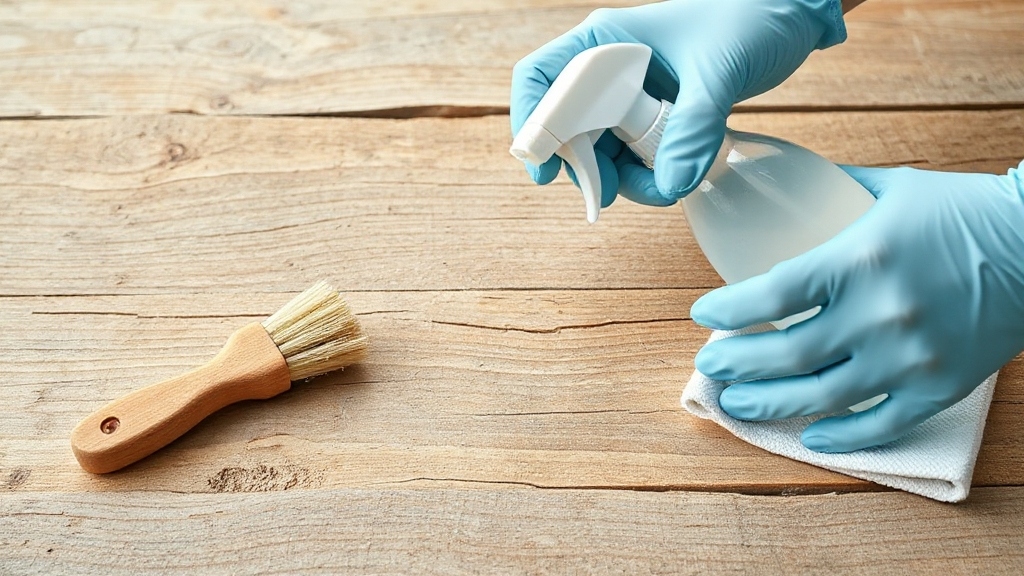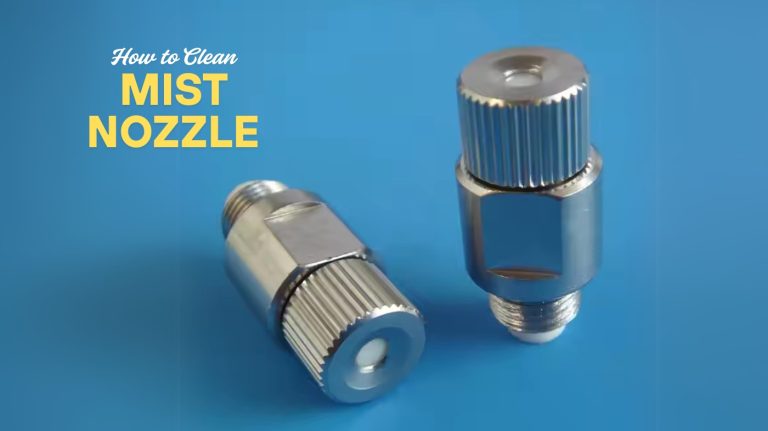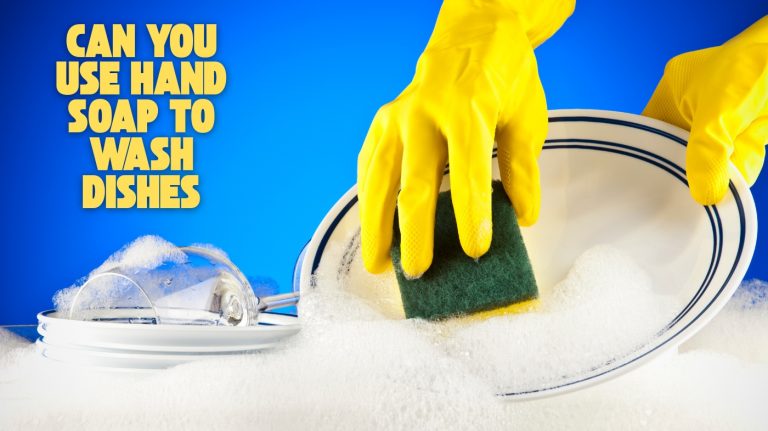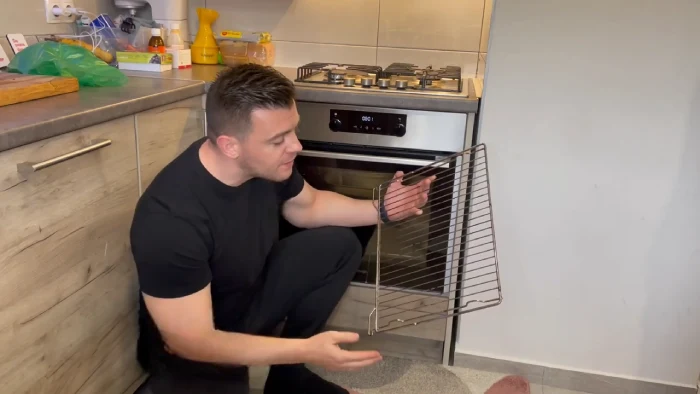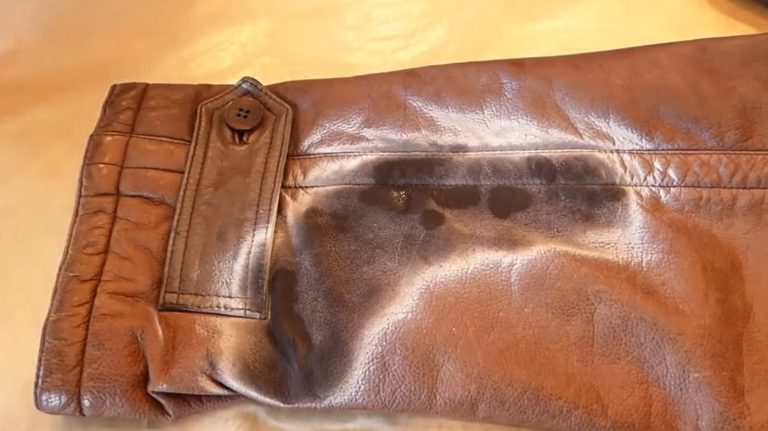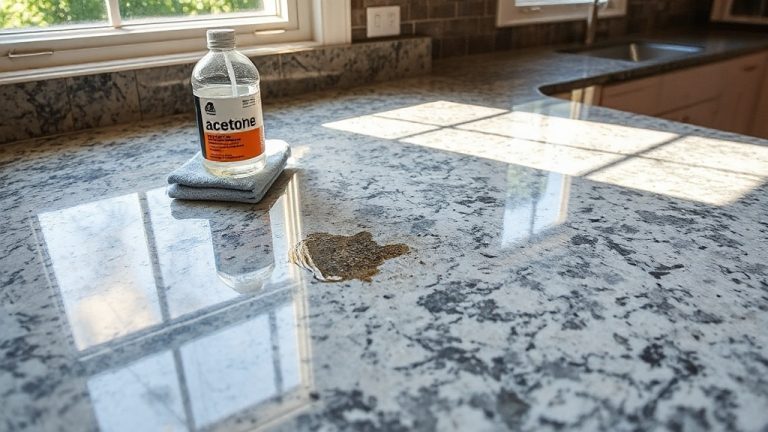How to Disinfect Unfinished Wood? Safe and Simple Steps
To disinfect unfinished wood safely, start by removing dust with a soft brush or microfiber cloth.
Use a diluted natural disinfectant like white vinegar (about 1 part vinegar to 16 parts water) applied with a damp, wrung-out cloth to avoid moisture damage.
Wipe along the grain and dry immediately to prevent warping. Avoid harsh chemicals and excess water.
Afterward, condition the wood with natural oils to maintain its integrity. Keep following for more detailed disinfection and care techniques.
Key Takeaways
- Use diluted natural disinfectants like white vinegar (1 cup per 16 cups water) applied with a damp, wrung-out cloth to avoid excess moisture.
- Gently wipe along the wood grain with a soft cloth to apply disinfectant evenly and prevent surface damage.
- Avoid saturating unfinished wood; immediately dry with a microfiber cloth to prevent warping or discoloration.
- Test disinfectant on a small, hidden area first to ensure it does not stain, warp, or damage the wood.
- After disinfecting, condition wood with natural oils like linseed or mineral oil to restore moisture and protect the surface.
The Nature of Unfinished Wood
Although unfinished wood might seem uniform at first glance, its cellular structure and chemical composition reveal a complex material influenced by species and growth conditions.
Wood cells mainly consist of cellulose, hemicellulose, and lignin, arranged in multi-layered walls with the middle lamella binding cells.
Pines and spruces, common softwoods, have a pith at the stem’s center, surrounded by heartwood and sapwood, which differ in moisture content and resin presence.
Proper ventilation is important when treating wood to avoid any exposure to potentially harmful fumes from cleaning agents such as natural cleaners.
Unfinished wood’s intricate cellular makeup varies by species and growth, revealing its complex natural structure.
Softwoods predominantly have tracheids, while hardwoods contain diverse cell types, affecting strength and water transport.
Chemically, wood comprises 18–35% lignin and 65–75% carbohydrates, with minor extractives and minerals influencing properties like decay resistance.
Its elemental makeup is roughly 50% carbon, 6% hydrogen, and 44% oxygen. Seasonal growth alters cell wall thickness, creating earlywood and latewood layers that impact density and moisture behavior.
Preparing Unfinished Wood for Disinfection
Start by removing all surface dust using a soft brush or vacuum with a brush attachment to prevent embedding dirt during cleaning.
Use a microfiber cloth to wipe the surface gently and remove any remaining dirt and stains. Choose mild cleaning solutions, such as diluted dish detergent mixed with bicarbonate soda and white vinegar, to avoid damaging the wood fibers.
Always test your chosen solution on a hidden area to verify it won’t cause staining or discoloration before applying it broadly.
Minimizing water use and drying the wood thoroughly after cleaning helps prevent moisture damage and maintains the wood’s natural condition minimize water use.
Additionally, managing moisture levels is crucial when cleaning to protect the wood’s integrity and avoid damage from excessive wetness or heat exposure, similar to precautions taken with steam cleaning painted walls.
Remove Surface Dust
Before applying any disinfectant to unfinished wood, you need to remove surface dust thoroughly to guarantee effective cleaning and prevent damage.
Start by using a soft-bristled paintbrush, holding it perpendicular to the surface to loosen dust gently without scratching. Wrap any metal ferrules with tape to avoid abrasions. For crevices, use circular brush motions to dislodge dirt.
After brushing, vacuum the surface using a brush attachment covered with fine mesh to safely remove residual dust, especially from pores and grain. It is important to avoid vacuum use on surfaces that are loose or fragile to prevent damage.
Finish by wiping with a dry or slightly dampened microfiber cloth, following the wood grain to capture remaining particles without embedding dirt. Using microfiber cloths is effective as they absorb dirt without damaging delicate surfaces.
Choose Mild Cleaners
After removing surface dust thoroughly, selecting the right cleaning agents plays a key role in preparing unfinished wood for disinfection.
Use mild cleaners like diluted vinegar solutions or mild dishwasher liquid, avoiding harsh chemicals such as bleach or ammonia.
Ensure all cleaners have a neutral pH and are diluted properly to protect the wood’s natural texture and color.
Applying cleaning solutions with care is important to prevent over-wetting, which can lead to damage or prolonged drying times due to moisture retention.
Apply with soft cloths or sponges, avoiding over-saturation, and dry the surface immediately after cleaning.
Consider using a gentle soap-based cleaner, known as The Soap That Gives Dirt A Lift, to effectively remove grime without damaging the wood.
Test Cleaning Solutions
Although selecting the right cleaning solution is essential, you must first test it on a small, inconspicuous area of the unfinished wood to guarantee it won’t cause staining or damage.
Prepare the cleaning solution by mixing agents with water at recommended ratios. Apply it with a sponge or microfiber cloth, working along the wood grain.
This method is similar to the spot inspection process used in thorough cleaning to identify affected areas before treatment.
After application, observe the spot for any discoloration, warping, or surface damage. If adverse effects occur, adjust the concentration or select an alternative agent, such as sodium percarbonate or mild vinegar solutions.
It is important to avoid using sodium hydroxide alone on unfinished wood as it can cause fiber lifting and damage.
Document your findings to ensure consistent results. Testing this way prevents irreversible damage and preserves the wood’s integrity, setting a reliable foundation for effective disinfection and subsequent conditioning.
Selecting Safe Natural Disinfectants
When you choose natural disinfectants for unfinished wood, you must prioritize agents that clean effectively without compromising the wood’s integrity.
Opt for substances that gently remove dirt, grease, and microbes while preserving moisture balance. Avoid harsh chemicals or excessive water exposure, which can cause swelling or fiber damage.
It is also advisable to conduct a test on inconspicuous areas to check for discoloration or sensitivity before full application.
Consider the following natural options:
- Diluted natural dish soap for safe, mild cleaning
- Linseed or mineral oils to nourish and protect wood
- Cedarwood essential oil blends for added antimicrobial effect
- Natural rubber erasers for precise, abrasion-free grime removal
- Biodegradable, non-toxic commercial cleaners free of ammonia and bleach
These choices maintain the wood’s texture and appearance, ensuring thorough disinfection without inducing drying, cracking, or residue buildup.
Maintaining moisture balance is key to preventing damage such as swelling or cracking during cleaning.
Proper Dilution and Mixing of Cleaning Solutions
When using vinegar to disinfect unfinished wood, keep the ratio at or below 50% vinegar to water to prevent surface damage.
Always mix cleaning solutions in clean containers and stir thoroughly to guarantee uniformity. Use precise measuring tools and wear protective gear to maintain safety during preparation.
Unfinished or unsealed hardwood requires alcohol-based disinfectants, avoiding harsh chemicals that can harm the porous surface.
Additionally, applying disinfectants with gentle dabbing motions helps prevent saturation and damage to the wood finish.
Correct Vinegar-to-Water Ratio
How much vinegar should you mix with water to clean unfinished wood effectively without causing damage? The ideal ratio balances disinfection with wood safety.
For general cleaning, use 1 part white distilled vinegar to 3 parts water. Avoid higher concentrations like 50:50, which risk corrosion and discoloration on porous surfaces.
It is important to ensure proper dilution to maintain both cleaning efficiency and surface compatibility. For heavier soil, dilute 1 cup vinegar per gallon water, but always test first.
Key points to remember:
- Use only white distilled vinegar to prevent staining.
- Maintain a minimum acidity to kill bacteria effectively.
- Avoid over-concentration to protect wood fibers and natural oils.
- Prepare fresh solutions with warm, not hot, water.
- Test on a hidden area to ensure no damage or color change.
- Vinegar acts as a natural disinfectant by killing bacteria and germs safely on wood surfaces.
This ratio ensures thorough cleaning while preserving unfinished wood integrity.
Safe Mixing Techniques
Mixing cleaning solutions correctly guarantees you safeguard unfinished wood from damage while maximizing disinfection.
Start by preparing solutions in a well-ventilated area, wearing gloves if needed. Use mild ingredients like vinegar diluted with water or a small amount of mild dish soap.
It is also important to always test cleaners first on an inconspicuous area to prevent stains, rot, and damage caused by unsuitable products. Avoid harsh chemicals such as ammonia or bleach, which can discolor or degrade the wood.
Always test any mixture on a hidden spot to check for adverse effects. When applying, ensure your microfiber cloth is damp, not saturated, to prevent moisture absorption that leads to warping or mold.
Rub gently along the wood grain to avoid scratches. After cleaning, you can condition the wood with olive oil, applied sparingly and following the grain, to restore moisture and protect the surface without leaving residue.
Additionally, maintaining stable indoor humidity helps reduce moisture-related issues such as mold growth and warping in unfinished wood.
Effective Techniques for Applying Disinfectants
Although unfinished wood requires careful handling, you can effectively disinfect it by selecting appropriate application methods that minimize moisture exposure and surface damage.
Start by preparing a diluted disinfectant, like a 1:1 vinegar-water solution, and test it on a hidden spot to check for discoloration.
Begin with a diluted disinfectant, such as a 1:1 vinegar-water mix, testing on a hidden area first.
Use a damp microfiber cloth or sponge, applying the disinfectant evenly along the wood grain. Avoid saturating the surface, and wipe dry immediately to prevent absorption. It is important to avoid excessive water exposure to prevent swelling or warping of the wood.
Key application tips include:
- Use low-moisture, non-abrasive disinfectants
- Apply disinfectant with a damp cloth or sponge
- Follow wood grain direction for even coverage
- Test on a concealed area first
- Wipe dry promptly to remove residue and limit wetness
Avoiding Moisture Damage During Cleaning
When cleaning unfinished wood, you must minimize moisture exposure to prevent absorption and damage. Use only damp—not wet—cloths or sponges, wringing them out thoroughly before wiping.
Apply cleaning solutions sparingly, wiping immediately to avoid lingering moisture. Avoid soaking the wood or using large amounts of water, as unfinished wood is highly porous and vulnerable to water damage.
After cleaning, dry the surface promptly with a microfiber cloth or soft towel. Opt for low-moisture cleaners like a diluted white vinegar solution or mild dish soap in warm water, and always test solutions on inconspicuous areas first.
Use soft-bristled brushes or lightly dampened sponges, working along the grain to control moisture.
Quick, even cleaning prevents localized soaking and reduces risks of mold, decay, and pest infestations linked to moisture retention.
Dealing With Stubborn Stains and Dirt
If you encounter stubborn stains or dirt on unfinished wood, you’ll need targeted methods to remove them without causing damage.
Start by testing any solution on a discreet area. Use a damp cloth to apply cleaning agents sparingly, avoiding over-saturation.
For persistent stains, consider these options:
- Oxalic acid to remove mineral-based discolorations
- Bleach for lightening stains, applied cautiously
- Lacquer thinner or acetone for tough marks
- Steel wool pads for surface stain removal without sanding
- Diluted natural soap solution for gentle dirt removal
Oxalic acid is particularly effective in lightening mineral stains caused by iron rust, making it a preferred choice for reclaimed lumber treatment.
Always work in a well-ventilated space, wear protective gloves, and avoid soaking the wood. These precise methods help maintain wood integrity while effectively addressing stubborn stains and dirt.
Conditioning Unfinished Wood After Disinfection
After disinfecting unfinished wood, you’ll want to restore its natural oils and protect the surface to prevent drying and damage. Start by ensuring the wood is clean, dry, and free of debris.
Light sanding with fine-grit sandpaper (220 grit) helps smooth the surface. Choose natural oils like Danish, linseed, or mineral oil; avoid harsh solvents.
Regular application of these oils nourishes the wood from within, replenishing its natural oils and providing moisture and UV protection.
Apply several thin coats using a soft cloth or brush, working with the grain, allowing adequate drying time between layers.
For added protection, consider a beeswax-based paste wax, applied in one or two coats and buffed to a smooth, matte finish.
Avoid over-application to maintain breathability. Finally, position the wood away from direct sunlight and maintain stable humidity to prolong its condition and prevent warping or cracking.
Tools That Enhance Cleaning Efficiency
Although disinfecting unfinished wood is essential, using the right tools considerably boosts cleaning efficiency and protects the surface.
Selecting appropriate instruments ensures thorough dirt removal without damaging the wood’s porous texture.
Because unfinished floors are highly absorbent and vulnerable to moisture damage, it is crucial to avoid tools that introduce excessive water or abrasion during cleaning to preserve the wood’s condition. Unfinished floors vulnerability
For ideal results, you should rely on tools designed to handle delicate surfaces and hard-to-reach areas.
Consider incorporating these tools into your cleaning routine:
- Microfiber cloths to lift dust and dirt gently
- Soft bristle brushes for crevices and corners
- Gum erasers to remove marks without abrasion
- Adhesive rubber for controlled dirt extraction
- Spray bottles for even application of cleaning solutions
Environmental and Safety Best Practices
Proper tool selection enhances cleaning efficiency, but ensuring environmental and personal safety during disinfecting is equally important.
Use natural, non-toxic disinfectants like diluted white vinegar (1 cup per 16 cups water) to protect indoor air quality and reduce chemical residues.
Avoid saturating unfinished wood with liquids; use damp, wrung-out cloths to prevent moisture absorption, warping, or fungal growth.
Immediately dry surfaces with lint-free towels and provide adequate ventilation to inhibit mold.
Always wear gloves and eye protection, and work in well-ventilated areas to avoid inhaling fumes.
Follow manufacturer guidelines for all cleaning agents, test new solutions on inconspicuous spots, and dispose of waste per local regulations.
Avoid abrasive tools to preserve wood integrity and minimize contaminant vulnerability, ensuring both environmental protection and personal safety during your disinfecting process.
Frequently Asked Questions
Can Unfinished Wood Be Safely Disinfected Outdoors?
You can safely disinfect unfinished wood outdoors by choosing methods that avoid moisture and harsh chemicals. Use dry techniques like UV light or ozone generators, which minimize damage and mold risk.
Always disinfect in dry, shaded conditions to prevent warping or discoloration. Wear protective gear and ensure good ventilation.
Test any method on a small area first to confirm it won’t harm the wood or alter its appearance before full application.
How Often Should Unfinished Wood Be Disinfected?
You should disinfect unfinished wood based on its use and exposure. For indoor furniture, weekly light cleaning with occasional mild disinfecting suffices. High-touch areas may need more frequent attention.
Outdoor or moisture-exposed wood requires inspection and disinfecting after wet conditions to prevent mold. Avoid over-disinfecting to protect the wood’s integrity.
Prioritize routine cleaning and maintenance to minimize disinfecting frequency while preserving the unfinished wood’s surface.
Are There Disinfectants Safe for Unfinished Wood Pets Can Tolerate?
Yes, you can use pet-safe disinfectants on unfinished wood. Choose non-toxic cleaners like Vermont Natural Coatings Wood Cleaner or EPA-registered products such as Force of Nature, which use natural ingredients and kill 99.9% of germs.
Avoid harsh chemicals like ammonia or chlorine. You can also try diluted lemon juice or vinegar solutions.
Always test on a small area first, apply carefully, and guarantee the wood dries completely before letting pets back in to prevent irritation or ingestion.
Can Unfinished Wood Be Disinfected Without Affecting Its Color?
You might think disinfecting unfinished wood always risks color changes, but you can actually do it safely. Use a mild 1:1 white vinegar-water mix, applying it briefly and wiping dry immediately to avoid moisture damage.
Avoid harsh chemicals or bleach, which strip color. Gentle cleaning tools like damp microfiber cloths or adhesive rubbers also preserve color integrity. Always test first on hidden areas to ensure no discoloration occurs.
What Are Signs Unfinished Wood Is Over-Cleaned or Damaged?
You’ll notice signs of over-cleaning unfinished wood like discoloration, blotching, and raised grain from excess moisture. Surface dullness and scratches indicate abrasive damage.
Chemically, sticky residues or uneven absorption show improper cleaning. Physically, warping, cracking, or powdering means the wood’s fibers are compromised.
Also, avoid excessive water use and abrasive tools, as they cause swelling, mold risk, and surface degradation. Recognizing these helps you prevent irreversible damage.
Maintain Your Unfinished Wood’s Natural Beauty and Strength
Now that you understand how to safely disinfect unfinished wood without damaging its surface, are you ready to protect your wood while maintaining its natural beauty?
By preparing the wood properly, choosing the right natural disinfectants, and applying them with care, you guarantee effective cleaning.
Remember to condition the wood afterward to preserve its integrity. Following these precise steps and safety practices guarantees both cleanliness and longevity for your unfinished wood surfaces.

